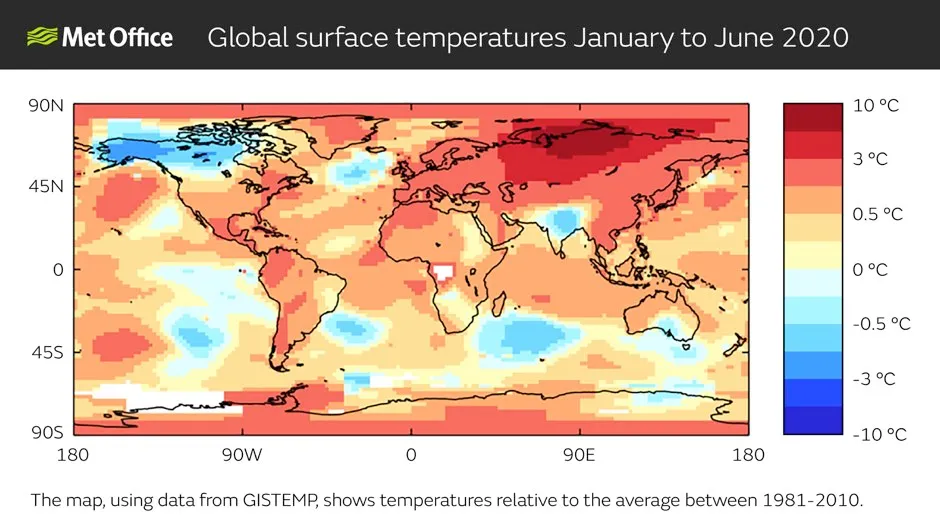The heatwave which has hit Siberia over the last six months would have been “effectively impossible” without climate change caused by humans, scientists have found.
The region has been experiencing unusually hot conditions since the beginning of 2020, while June saw a new reported record high Arctic temperature of 38°C at Verkhoyansk, Russia.
A rapid analysis of the conditions found the prolonged heat over the region since January was made at least 600 times more likely to occur because of human activity driving global warming.
It is the strongest result of any study by the World Weather Attribution initiative in attributing extreme events to climate change, the team behind the analysis said.
Read more about climate change:
- 20 per cent chance of missing Paris Agreement climate target in next five years
- Effects of emission cuts on climate change 'may take decades'
- Rapid Ice Age retreat of Antarctic ice gives stark climate change warning
Siberia’s heatwave, with temperatures 5°C warmer than average in the past six months, has caused widespread wildfires, pumping millions of tonnes of carbon dioxide into the atmosphere which will further drive warming.
It is also melting permafrost – permanently frozen ground – which caused the collapse of a fuel tank and huge oil spill in May, and causing an outbreak of the pest Siberian silk moth.
The high temperatures in the Arctic are helping drive 2020 to being one of the hottest years on record.

The team of scientists from around the world, including from the Met Office and Oxford University, applied methods previously used to analyse the impact of human-caused climate change on other extreme events, including storms and heatwaves in the UK, to assess its role in the Siberian heat.
They ran computer simulations to compare today’s world with 1°C of global warming to the climate, to what it would have been without human activity putting greenhouse gas emissions into the atmosphere that warm the world.
They examined average temperatures through the six months from January to June over a large region spanning most of Siberia, and also looked at daily maximum temperatures in June in the town of Verkhoyansk.
Read more:
- Why a carbon tax could be the answer to climate change
- Climate change: should we change the terminology?
- Science Focus Education Pack: Climate change
Even with climate change, such a period of heat – influenced by a strong jet stream in the winter creating warm conditions and causing melting snow and ice which further pushed up temperatures as dark soils absorbed warmth – would be very unlikely, occurring once every 130 years.
But without humans causing global warming, it would be almost impossible, taking place just once in 80,000 years.
The researchers also found the six-month hot spell is 2°C warmer than it would have been in 1900, before climate change took hold.
The analysis has not been peer reviewed, but uses scientific methods which have been previously published.
Lead author Andrew Ciavarella, from the Met Office, said: “Heatwaves and high temperatures occur naturally and human influence has a hand in changing the odds of just how warm they will be when they come along, and also how frequently they come along.
“We found the regional temperatures experienced over the six months to June 2020 have been made at least 600 times more likely to occur as a result of human-induced climate change and would have been effectively impossible without human influences.”
He said the probability of the mercury hitting the record 38°C in Verkhoyansk, has also “likely increased dramatically” because of global warming, though the researchers are less confident of those results.
The study also found temperatures could increase by 0.5°C to 5°C for the region for the first six months of the year by 2050, compared with today.
Dr Friederike Otto, acting director of Oxford’s Environmental Change Institute, and co-lead of the World Weather Attribution initiative, said: “This study shows again just how much of a game changer climate change is with respect to heatwaves.
“Given that heatwaves are by far the deadliest extreme weather events in most parts of the world they must be taken very seriously.”
Reader Q&A: Could climate change turn Earth into Venus?
Asked by: Andrew Kemp, Cheshire
Venus’s atmosphere is 96 per cent carbon dioxide, driving a powerful greenhouse effect that creates surface temperatures of up to 450°C. Earth’s atmosphere, on the other hand, currently contains 0.04 per cent carbon dioxide, with trace amounts of other greenhouse gases.
While greenhouse gas concentrations have been rising as we burn fossil fuels, they are still far from Venus’s levels. Even if we were to burn all available fossil fuels, the likely impact on our planet’s temperature would be a 10°C rise.
This may seem modest by Venus’s standards, but it would be enough to cause a sea level rise of more than 50 metres.
Read more:
